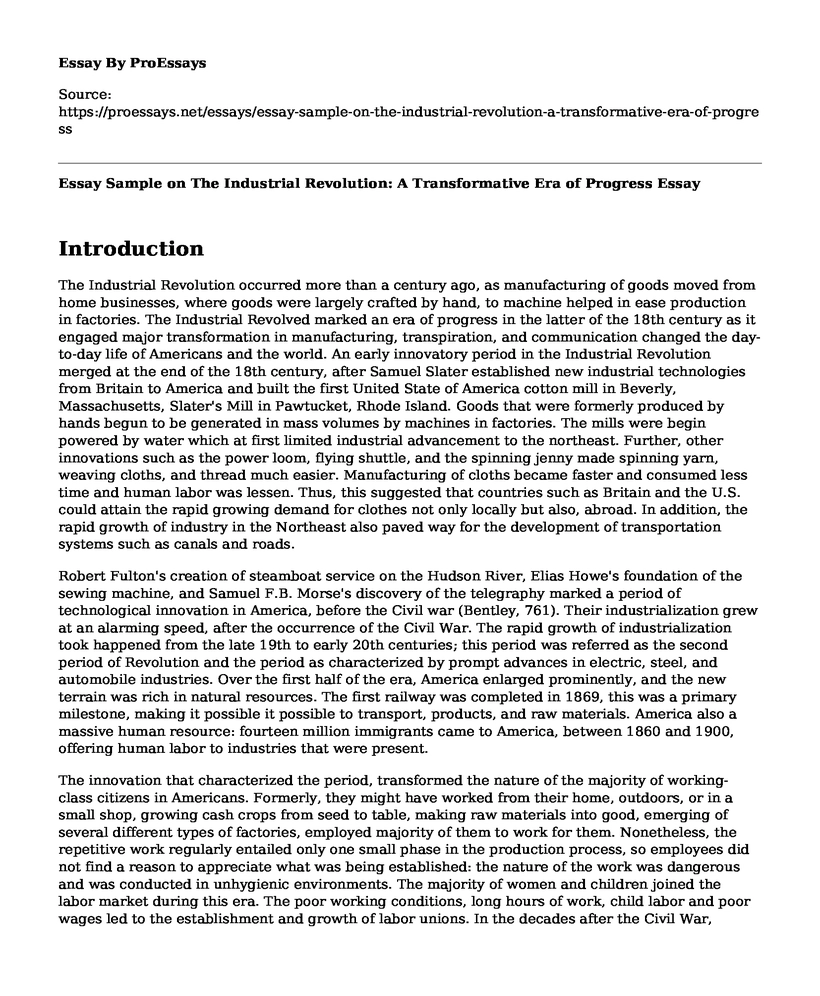Introduction
The Industrial Revolution occurred more than a century ago, as manufacturing of goods moved from home businesses, where goods were largely crafted by hand, to machine helped in ease production in factories. The Industrial Revolved marked an era of progress in the latter of the 18th century as it engaged major transformation in manufacturing, transpiration, and communication changed the day-to-day life of Americans and the world. An early innovatory period in the Industrial Revolution merged at the end of the 18th century, after Samuel Slater established new industrial technologies from Britain to America and built the first United State of America cotton mill in Beverly, Massachusetts, Slater's Mill in Pawtucket, Rhode Island. Goods that were formerly produced by hands begun to be generated in mass volumes by machines in factories. The mills were begin powered by water which at first limited industrial advancement to the northeast. Further, other innovations such as the power loom, flying shuttle, and the spinning jenny made spinning yarn, weaving cloths, and thread much easier. Manufacturing of cloths became faster and consumed less time and human labor was lessen. Thus, this suggested that countries such as Britain and the U.S. could attain the rapid growing demand for clothes not only locally but also, abroad. In addition, the rapid growth of industry in the Northeast also paved way for the development of transportation systems such as canals and roads.
Robert Fulton's creation of steamboat service on the Hudson River, Elias Howe's foundation of the sewing machine, and Samuel F.B. Morse's discovery of the telegraphy marked a period of technological innovation in America, before the Civil war (Bentley, 761). Their industrialization grew at an alarming speed, after the occurrence of the Civil War. The rapid growth of industrialization took happened from the late 19th to early 20th centuries; this period was referred as the second period of Revolution and the period as characterized by prompt advances in electric, steel, and automobile industries. Over the first half of the era, America enlarged prominently, and the new terrain was rich in natural resources. The first railway was completed in 1869, this was a primary milestone, making it possible it possible to transport, products, and raw materials. America also a massive human resource: fourteen million immigrants came to America, between 1860 and 1900, offering human labor to industries that were present.
The innovation that characterized the period, transformed the nature of the majority of working-class citizens in Americans. Formerly, they might have worked from their home, outdoors, or in a small shop, growing cash crops from seed to table, making raw materials into good, emerging of several different types of factories, employed majority of them to work for them. Nonetheless, the repetitive work regularly entailed only one small phase in the production process, so employees did not find a reason to appreciate what was being established: the nature of the work was dangerous and was conducted in unhygienic environments. The majority of women and children joined the labor market during this era. The poor working conditions, long hours of work, child labor and poor wages led to the establishment and growth of labor unions. In the decades after the Civil War, employees planned strikes and work go-slows, which assisted to expose the challenges that they are undergoing. One noteworthy labor strikes took place in 1877 was known as the Great Railroad Strike. Wages reduction in the railroad industry caused the upheaval that started in West Virginia and extended to three other states over duration of 45 days before being fiercely ended by a mixture of Nation Guardsmen, vigilantes, and Federal troops (Bentley, 781). Parallel incidences happened more regular in the following decades as employees planned and stressed themselves against alleged injustices. The new jobs for the working class established in the cities. Therefore, the Industrial Revolution started the switch from rural to urban settlements in the U.S. Youths raised on farms were more attracted by white-collar job and moved into cities (Bentley, 771). Suddenly cities began to encounter challenges such as overcrowding, shortage of housing facilities and majority of the middle and loss class citizen found themselves in slums. Such a situation provides an account of the presences of slums in the world.
Conclusion
The Industrial Revolution is a multifaceted set of technological economic and social changes that befell over a considerable period. Industrial Enlightenment led to the growth of urban areas accompanied the period; nonetheless, the period introduced problems such as the growth of slums.
Work Cited
Bentley, Jerry H., et al. "Traditions & encounters: a global perspective on the past." (2006). retrieved from: http://www.mikesilber.com/uploads/2/1/2/3/21230496/apwh_chapt_1_ppt.pdf
Cite this page
Essay Sample on The Industrial Revolution: A Transformative Era of Progress. (2023, Mar 12). Retrieved from https://proessays.net/essays/essay-sample-on-the-industrial-revolution-a-transformative-era-of-progress
If you are the original author of this essay and no longer wish to have it published on the ProEssays website, please click below to request its removal:
- Essay Example on The Presence of Ancient Aliens
- Research Paper on American Liberty
- Canada's Strategy During World War One - Essay Sample
- Essay Example on Artist Sam Gilliam's Mental Health Fight: A Case Study
- Essay on Life After Slavery: End of Injustices & Brutality in the South
- Essay Example on Robber Barons: Self-Interest Leads to Generosity
- The Abolition of Slavery: Its Impact on America's Rise - Interview Example







